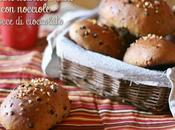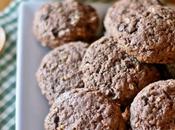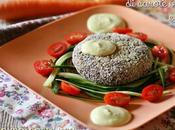 Scroll Down for English Version Qualche sabato fa ho comprato mezzo chilo di peperoncini rossi tondi. Sono della varietà piccante che si conserva sott'olio e di solito si farciscono con acciughe e capperi. Io ho voluto aggiungere anche del tonno, come fa mia mamma per preparare un ripieno gustoso ma che non fosse troppo forte e che non sovrastasse, se è possibile, il sapore del peperoncino. Armata di pazienza e piena di aspettative, mi sono messa a studiare le varie ricette che si trovano in rete e naturalmente alla fine ho deciso di fare di testa mia, attenendomi alle regole delle sterilizzazione e della perfetta pulizia dei contenitori affinché questo tipo di cibo conservato possa essere consumato in tutta tranquillità.
Scroll Down for English Version Qualche sabato fa ho comprato mezzo chilo di peperoncini rossi tondi. Sono della varietà piccante che si conserva sott'olio e di solito si farciscono con acciughe e capperi. Io ho voluto aggiungere anche del tonno, come fa mia mamma per preparare un ripieno gustoso ma che non fosse troppo forte e che non sovrastasse, se è possibile, il sapore del peperoncino. Armata di pazienza e piena di aspettative, mi sono messa a studiare le varie ricette che si trovano in rete e naturalmente alla fine ho deciso di fare di testa mia, attenendomi alle regole delle sterilizzazione e della perfetta pulizia dei contenitori affinché questo tipo di cibo conservato possa essere consumato in tutta tranquillità. Per quanto riguarda e vasi da utilizzare, vi suggerisco quelli con il tappo a vite non quelli con la guarnizione che si vedono nella mia foto. Avevo usato quello con la guarnizione perché hanno l'imboccatura larga ed è più facile sistemare i peperoncini al loro interno ma al momento della sterilizzazione in pentola ho notato che un po' d'olio fuoriusciva dai vasi. Non mi sono fidata a metterli via per l'inverno, li ho messi in frigo e li ho consumati nel giro di una decina di giorni, complici le sorelle numero 3 e 4 che sono venute a trovarmi per qualche giorno e che hanno apprezzato moltissimo i miei peperoncini ripieni.
Quanto all'olio da utilizzare per la conservazione ho voluto fare un esperimento perché pensavo che l'olio di oliva fosse troppo forte, così ho fatto un vasetto anche con l'olio di semi. A mio gusto sono risultati più buoni i peperoncini conservati in olio d'oliva, mentre la sorella numero 4 preferiva quelli in olio di semi. La sorella numero 3 ha mangiato volentieri entrambi. A voi la scelta.
Per due barattoli da 500 ml:
- 500 g di peperoncini piccanti rotondi rossi
- 300 ml di aceto di vino bianco o aceto di alcool
- 400 m di acqua
- 500 ml di olio di semi o extra vergine d'oliva
- 320 g di tonno in olio di oliva,
- 2 cucchiai di capperi sotto sale
- 6 filetti di acciuga sott'olio
- qualche rametto di timo fresco
Pulite i peperoncini togliendo la calotta superiore e i semini all'interno. Potete utilizzare un cucchiaino da caffè per rimuovere i semi. Mettete a bollire l'aceto e l'acqua in una pentola e scottate i peperoncini, un po' per volta per qualche minuto. Metteteli ad asciugare a testa in giù su un telo pulito e lasciateli così per una notte. Lavate i vasi si vetro con acqua calda e sapone e poi metteteli ad asciugare in forno a 120° per almeno mezz'ora. Preparare il ripieno scolando bene il tonno, mettetelo nel mixer, aggiungete gli altri ingredienti, scartando i rametti di timo e tenendo solo le piccole foglie, e frullate fino ad ottenere un composto omogeneo ma non troppo fine. Riempite i peperoncini aiutandovi con un cucchiaino da caffè e con un dito premete il ripieno. Non riempite troppo i peperoncini perché il ripieno potrebbe fuoriuscire una volta che saranno sommersi nell'olio e rendere quest'ultimo opaco. Coprite con l'olio e fate riposare per un paio di ore per permette all'olio di penetrare in ogni interstizio. Se necessario aggiungetene ancora un po' fino a coprire bene i peperoncini.Chiudete i vasi, metteteli in una pentola capiente, copriteli con acqua fredda e portate a bollore. Fate bollire per circa 15 minuti poi spengere il fuoco e far freddare i barattoli nell'acqua. Una volta freddi asciugateli e conservate il un luogo fresco al riparo dalla luce.
English Version A few Saturdays ago I bought half a kilo of round red chilli peppers. They are the hot variety that is preserved in oil and usually stuffed with anchovies and capers. I wanted to add tuna fish, as does my mother to make a tasty but not too overpowering filling. With a lot of patience and full of expectations, I started to look at the many recipes available on the net, and of course in the end I decided to go my own way, following the rules of sterilization and thoroughly cleaning the jars so that the food can be preserved safely. I suggest using mason jars for these recipe, not the ones with the rubber seal you see in the photo. I used the ones with the rubber seal because they have the wider opening and it’s easier to arrange the peppers in them, but when I was boiling them in the pot I noticed a little oil leakage from the jars. I wasn’t sure about putting them away for the winter, so I put them in the fridge instead and they were gone in a matter of ten days. The fact that the sisters number 3 and 4 came to visit for a few days and that they greatly enjoyed my stuffed chilli peppers it helped a lot. I wasn’t sure which kind the oil I should have used for preserving because I thought that olive oil was too strong, so I made a jar using vegetable oil. To my taste the chilli peppers preserved in olive oil were nicer, while sister number 4 preferred to those in vegetable oil. Sister number 3 has willingly eaten both. The choice is yours. For two 500ml jars:
- 500 g red hot round peppers
- 300 ml white wine vinegar or white vinegar
- 400 m water
- 500 ml vegetable oil or extra virgin olive oil, to your liking
- 320 g tuna in olive oil,
- 2 tablespoons capers preserved in salt
- 6 anchovy fillets preserved in oil
- a few sprigs of fresh thyme






